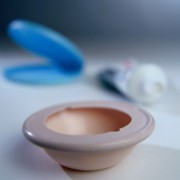 Photo: Getty Images
Photo: Getty Images
A diaphragm is a shallow dome-shaped cup made of thin, flexible rubber. It works by creating a barrier between sperm and your uterus. It’s inserted into the vagina and slides into place behind the pubic bone, completely covering the cervix. This prevents fertilization between egg and sperm.
Diaphragms can be inserted up to six hours prior to intercourse. In order to be the most effective, diaphragms must be used with spermicide cream or jelly. Placed inside the dome and around the rim, spermicide helps kill sperm.
To insert the diaphragm, pinch the rim of the cup together, so it folds in half. Push it inside the vagina until the diaphragm can’t move anymore. You shouldn’t be able to feel the diaphragm.
The diaphragm needs to be inserted up to six hours before having sex. Additional spermicide should be used if sexual intercourse takes place more than three hours after inserting the diaphragm.
After sex, the diaphragm must be left in for at least six hours, but no longer than 24 hours. If left in for more than 24 hours, it can increase the risk of toxic shock syndrome. The diaphragm is removed by placing a finger in the vagina to pull it out.
Unlike other birth control options, diaphragms must be fitted by a health care provider. During a pelvic exam the vagina is measured to determine the necessary size of the diaphragm. During this time, doctors review proper diaphragm use.
Diaphragms may last two or three years. Each time it’s removed, it needs to be washed with mild soap and warm water, allowed to air dry and placed inside its protective case. Don’t dust it with powder or ever use it with oil-based lubricants such as petroleum jelly or baby oil. These can cause the rubber to become brittle and crack. Other vaginal creams, such as yeast medicines, can also damage the rubber.
Diaphragms can still be used if the latex becomes discolored. But if the latex is wrinkled — especially near the rim — it’s become too thin. Diaphragms should be examined regularly. Look for small holes or weak spots by holding it up to the light or fill the cup with water to look for leaks.
Check diaphragm fittings every year or so. Weight gain or loss and childbirth can mean the diaphragm will no longer fit properly and increase pregnancy chances.
Diaphragms don’t protect against sexually transmitted diseases (STDs). Using a condom with a diaphragm offers better protection against them.
Stacy Lloyd is a writer and video producer. A former television news journalist, she covered stories around the world. Currently, she produces corporate and non-profit videos and broadcast programming.





Add a CommentComments
There are no comments yet. Be the first one and get the conversation started!